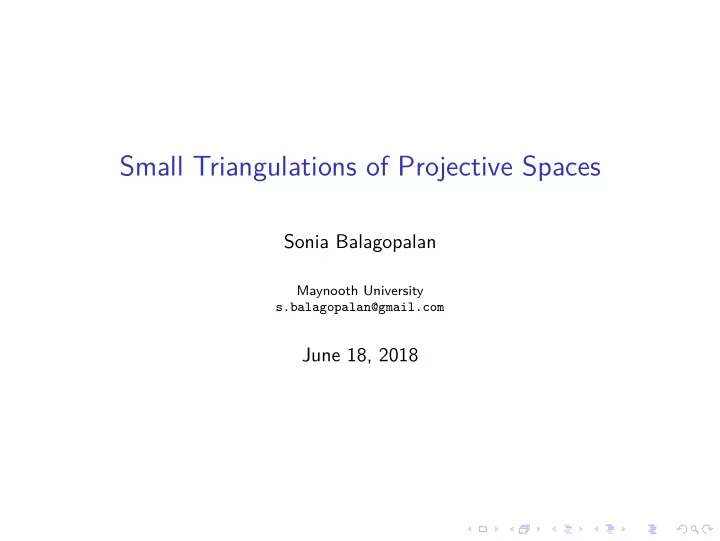

Small Triangulations of Projective Spaces Sonia Balagopalan Maynooth University s.balagopalan@gmail.com June 18, 2018
What do we mean by Triangulations? Simplicial Complexes An abstract simplicial complex is a collection of sets closed under inclusion. We think of this as a subset of P ([ n ]). ◮ Let K be a simplicial complex with vertex-set [ n ]. The geometric carrier of K is constructed by extending the map i �→ e i in R n . ◮ Let X be a (compact, connected, . . . ) manifold. A triangulation of X is a simplicial complex K , whose geometric carrier is (PL-)homeomorphic to X . ◮ The boundary of the n -dimensional simplex ( P ([ n + 1])) triangulates S n − 1 . ◮ A combinatorial d-manifold is a simplicial complex in which the link of every vertex is PL-homeomorphic to a ( d − 1)-sphere. Small triangulations are interesting !
R P 2 6 We can triangulate R P 2 with six vertices. [123] , [124] , [135] , [146] , [156] , [236] , [245] , [256] , [345] , [346] 4 3 5 6 1 2 6 5 4
Manifolds like a Projective Plane Eells and Kuiper classified “manifolds of Morse number 3”, compactifications of R 2 d by an d -sphere. They only exist in five different dimensions d . ◮ d = 0: Three points ◮ d = 2: Homeomorphic to real projective plane, R P 2 ◮ d = 4 , 8 , 16: Is simply connected, and has the same integral cohomology as the complex projective plane C P 2 , quaternionic projective plane H P 2 , or octonionic projective plane O P 2
Triangulations with few vertices Brehm, Kühnel (1987): Let M be a combinatorial d -manifold with n -vertices. Then, 1. if n < 3 ⌈ d 2 ⌉ + 3, then M is homoeomorphic to S d 2. if n = 3 ⌈ d 2 ⌉ + 3, then either M is homeomorphic to S d , or M is a manifold like a projective plane. If such a combinatorial manifold exists, we call it a BK-manifold.
Existence results: BK-manifolds d = 2 , n = 6 Classical R P 2 has a unique 6-vertex triangulation. d = 4 , n = 9 Kühnel, Lassman (1983) There exists a unique such combinatorial manifold, and it triangulates C P 2 . d = 8 , n = 15 Brehm, Kühnel (1992) There are six such combinatorial manifolds all triangulating the same cohomology H P 2 . Discovered by computer search! Gorodkov (2016) proved that these are homeomorphic to H P 2 . d = 16 , n = 27 Open!
How were these objects discovered? These triangulations have a large amount of symmetry, and satisfy very restrictive combinatorial properties, such as complementarity. 4 3 5 6 1 2 6 5 4 This helps in narrowing down the search space somewhat.
Real Projective Spaces Think of Real projective space of dimension d , R P d as the sphere S d with antipodal points identified. ( x ∼ − x ). R P d can be triangulated. Barycentric subdivision of the simplex Let ∆ d denote the d -dimensional simplex with vertices 1 , 2 , . . . , d + 1. The (first) barycentric subdivision of ∆ d is the complex obtained by subdividing ∂ ∆ d at each of its proper faces. 2 ◮ Antipodal d -sphere 12 124 24 ◮ Each vertex a nonempty, proper 4 1 14 subset of [ d + 2] ◮ 2 d +2 − 2 vertices 234 123 23 134 ◮ Each facet ∼ an ordering of [ d + 2] 34 13 ◮ ( d + 2)! facets ◮ Quotient is R P d 3
State of the art on triangulations of R P d ◮ The above construction uses n = 2 d +1 − 1 points to triangulate R P d . ◮ All known infinite families require O (2 n ) vertices. ◮ We know better constructions for d = 4 , 5 ◮ Best known lower bound for R P d is n = � d +2 � + 1 , d ≥ 3, due to 2 Arnoux, Marin (1991).
Trying to bridge the gap Bistellar Flips Given a combinatorial manifold M , let ∆ 1 be a simplex in M . Say the link of ∆ 1 in M is boundary ∂ ∆ 2 of another simplex ∆ 2 . Further suppose that ∆ 2 / ∈ M . Then replacing ∆ 1 ∗ ∂ ∆ 2 in M with ∂ ∆ 1 ∗ ∆ 2 gives a new combinatorial manifold M ′ that is PL-homeomorphic to M . Pachner’s Theorem Two combinatorial manifolds M and M ′ are PL -homeomorphic if and only if M can be obtained from M ′ through a sequence of bistellar flips. The BISTELLAR program Lutz (1999) applied a simulated annealing algorithm to start with large triangulations of manifolds and search for smaller ones. Geometric constructions are also possible with Polymake , SimpComp etc. But these need significant inspiration!
Open Problems Can we construct a 27-vertex O P 2 ? Can we do better than BISTELLAR ? Can R P d be triangulated with O ( d 2 ) vertices?
Recommend
More recommend